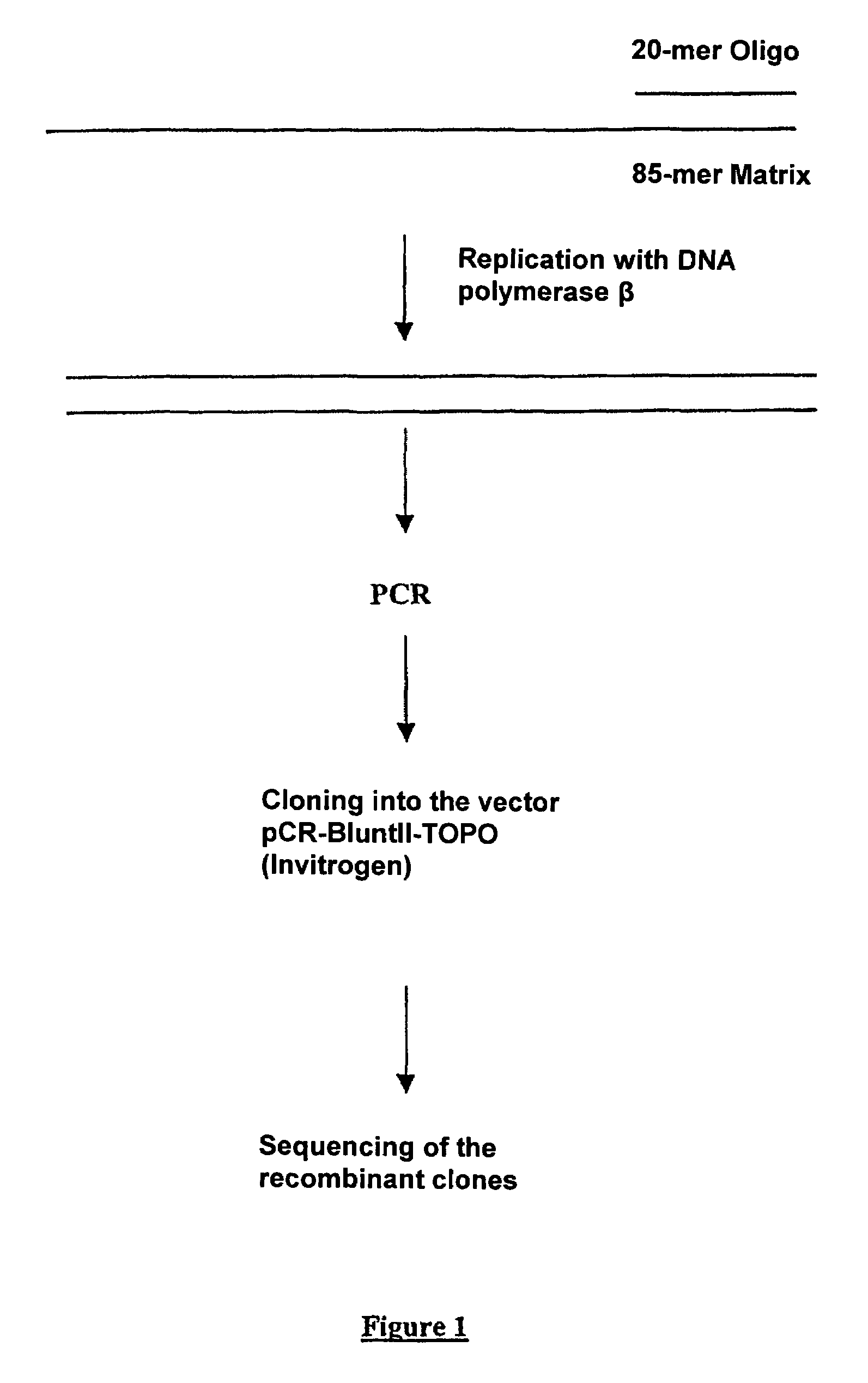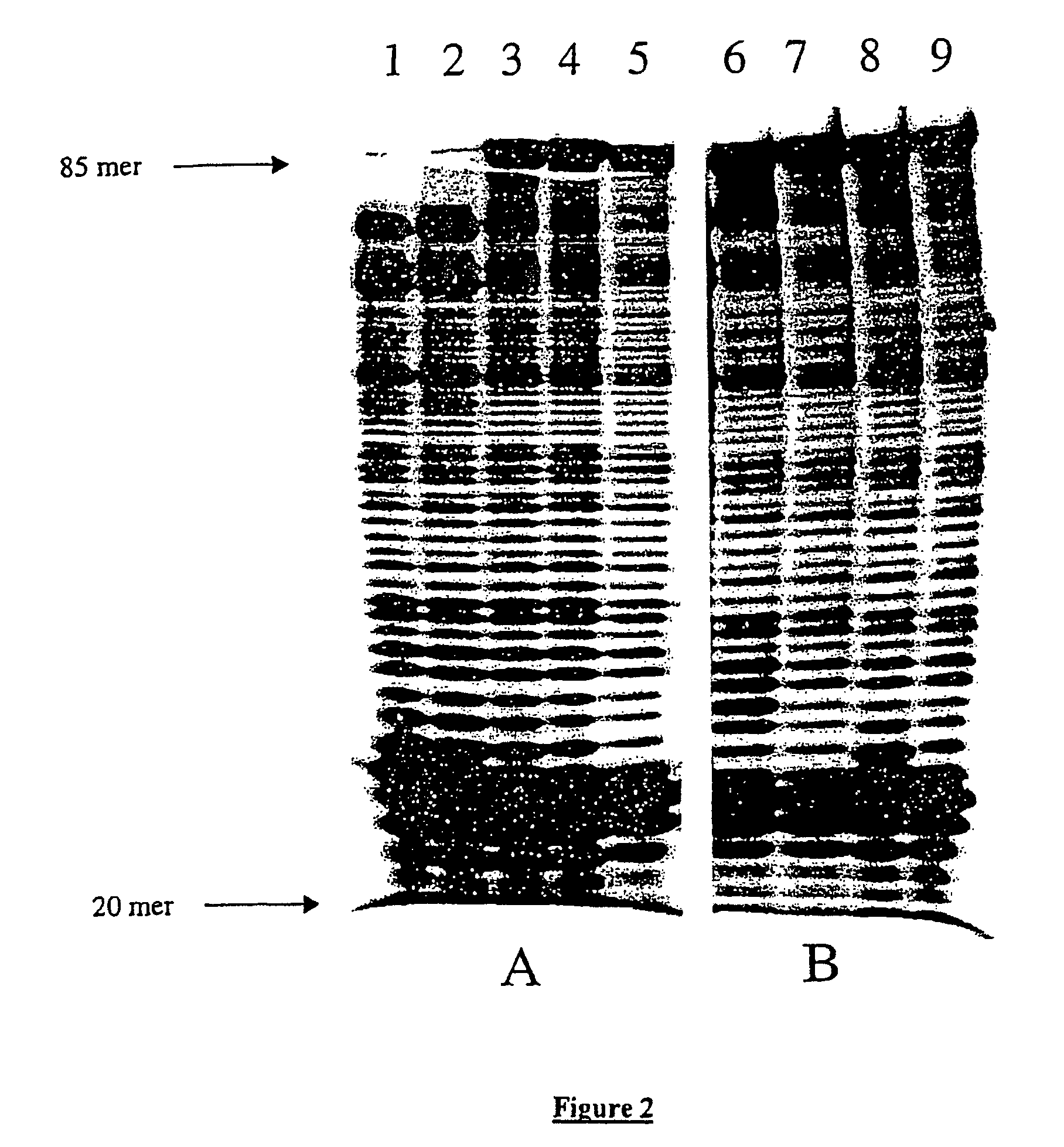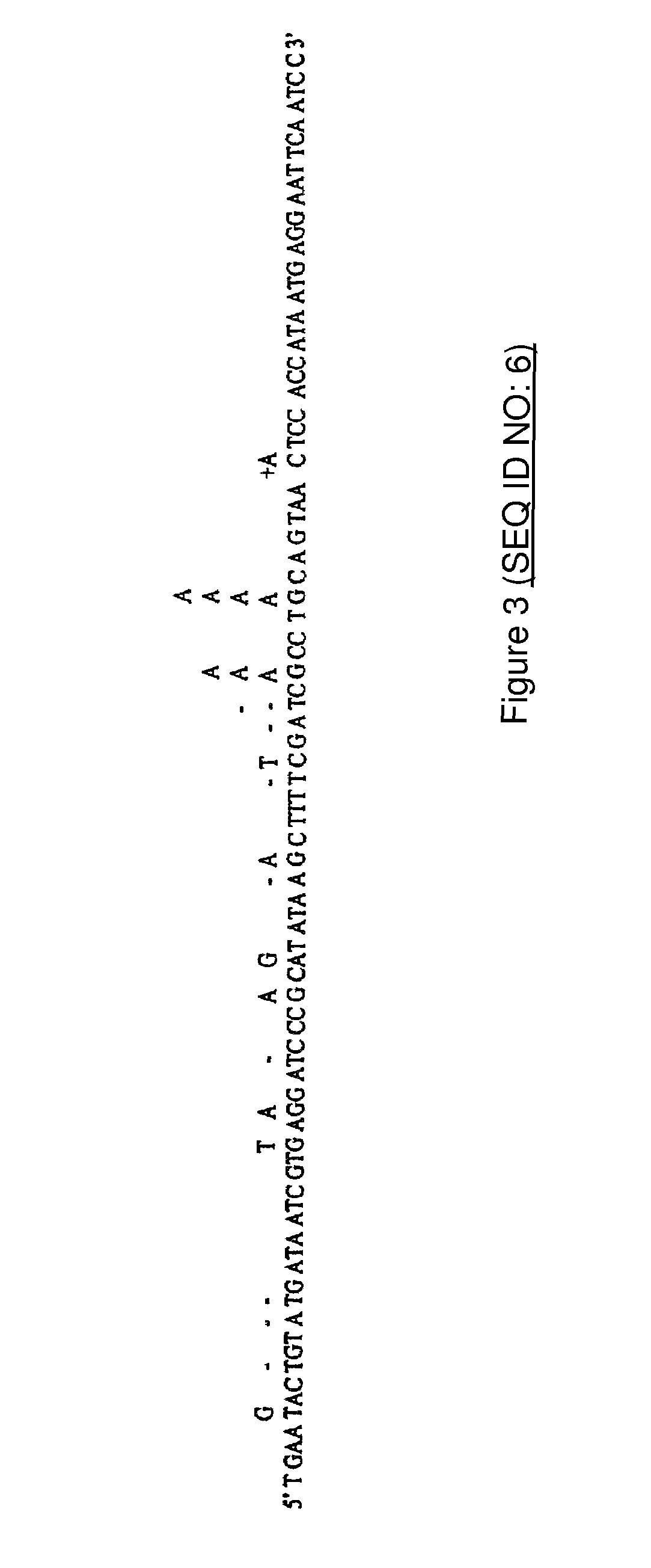Use of mutagenic DNA polymerase for producing random mutations
a technology of mutagenic dna and random mutation, which is applied in the field of using mutagenic dna polymerase for producing random mutations, can solve the problems of high cost, low mutagenesis rate, and inability to construct a mutant library
- Summary
- Abstract
- Description
- Claims
- Application Information
AI Technical Summary
Benefits of technology
Problems solved by technology
Method used
Image
Examples
example 1
[0041]In vitro production of random mutations by replication of an 85-mer polynucleotide with DNA Pol β and use of a biased pool of deoxynucleotides.
[0042]FIG. 1 shows very schematically the various steps of the method, from the polynucleotide to the sequencing of the recombinant clones:
[0043]Material:
[0044]
3′ primer:5′ GATTGAATTCCTCATTATGG 3′(SEQ ID NO: 1)5′ primer:5′ TGAATACTGTATGATAATCG 3′(SEQ ID NO: 2)85-mer matrix:5′ TGAATACTGTATGATAATCGTGAGGATCCCGCA(SEQ ID NO: 3)TATAAGCTTTTCGATCGCCTGCAGTAACTCCACCATAATGAGGAATTCAATC 3′
Culture Media
[0045]Complete LB medium: 1% tryptone, 0.5% yeast extract, 1% Nacl, H2O qs 1 l. 15 g of agar are added to 1 liter of LB to prepare the LB / agar medium.
[0046]SOC medium: 2% tryptone, 0.5% yeast extract, 10 mM NaCl, 2.5 mM KCl, 10 mM MgCl2, 10 mM MgSO4, 20 mM glucose.
Bacterial Strain and Vectors
[0047]
TABLE 4StrainsGenotypesSourcesTOP 10F− mcrA Δ(mrr-hsdRMS-mcrBc)InvitrogenΦ80lacZΔM15 ΔlacX74 recA1 deoRaraD139 Δ (ara-leu) 7697 galUgalK rpsL (StrR) endA1 nu...
example 2
[0065]In vitro production of random mutations in the lacZ gene carried by a plasmid vector.
[0066]The aim of this experiment is to perform SV40 replication of a pBK-CMV matrix (containing the SV40 origin, the Neor-Kanr double resistance gene and the sequence encoding the α-peptide of β-galactosidase allowing α-complementation in Δα-lacZ strains) with Hela extracts and the T antigen, and to add purified rat DNA Pol β during the experiments. The difference in frequency of mutagenesis induced by the excess of Pol β is measured using the mutagenesis test described below (white / blue screen).
Bacterial Strains, Plasmids, Restriction Enzymes
[0067]The plasmid pBK-CMV (Strategene) was amplified in a dam+ bacterium (DH5α) and purified using the Wizard Plus DNA Purification System (Promega). The DpnI enzyme comes from BioLabs.
[0068]
TABLE 5StrainsGenotypesSourcesMC1061Mut SF− araD139 Δ(araleu)7696 galE15T. Kunkel,galk16 ΔlacX74 rpsL (StrR) hsdR2(rK−USAmK+) mcrA mcrB1 [mutS : :Tn10]JM109F′ traD36 ...
example 3
Replication of the lacZ Gene by Pol β and Comparison with the Results Obtained by PCR with a taq Polymerase
[0077]This example shows that Pol β introduces a frequency of mutagenesis 50 times higher than that obtained with taq polymerase by PCR.
[0078]Random mutations were produced in vitro by replication of the lacZ gene encoding the α-peptide of β-galactosidase, carried by the plasmid pUC18 (invitrogen), with DNA polymerase β, and use of a biased pool of deoxynucleotides. FIG. 5 shows very schematically the various steps of the method followed, from the replication of the lacZ gene with the polymerase β to the sequencing of the mutant clones.
[0079]Material:
[0080]
(SEQ ID NO: 4)5′ primer:5′ CGCGACTCATGCGACGCATTACGAATTCGAGCTCGGTAC 3′(SEQ ID NO: 5)3′ primer5′ CACTCGACGCTGATGCAGTGCACCATATGCGGTGTG 3′
[0081]The parts underlined are the sequences complementary to the sequences in the 5′ and 3′ positions flanking the lacZ gene carried by the plasmid pUC18.
Culture Media
[0082]The composition of ...
PUM
| Property | Measurement | Unit |
|---|---|---|
| Temperature | aaaaa | aaaaa |
| Mass | aaaaa | aaaaa |
| Mass | aaaaa | aaaaa |
Abstract
Description
Claims
Application Information
 Login to View More
Login to View More - R&D
- Intellectual Property
- Life Sciences
- Materials
- Tech Scout
- Unparalleled Data Quality
- Higher Quality Content
- 60% Fewer Hallucinations
Browse by: Latest US Patents, China's latest patents, Technical Efficacy Thesaurus, Application Domain, Technology Topic, Popular Technical Reports.
© 2025 PatSnap. All rights reserved.Legal|Privacy policy|Modern Slavery Act Transparency Statement|Sitemap|About US| Contact US: help@patsnap.com



